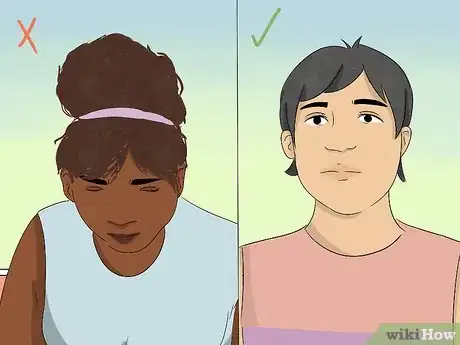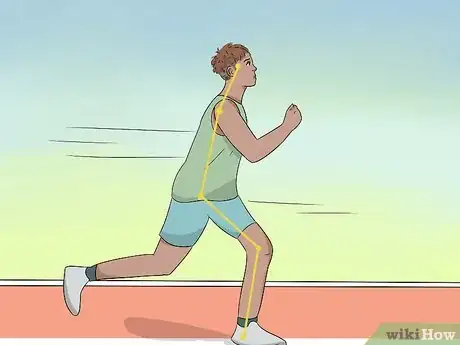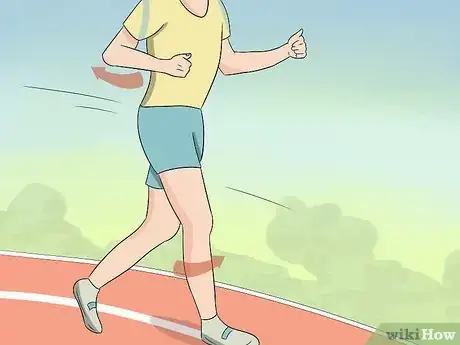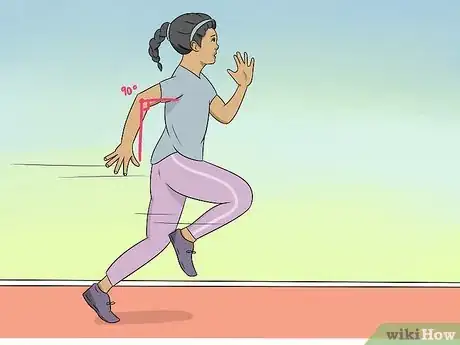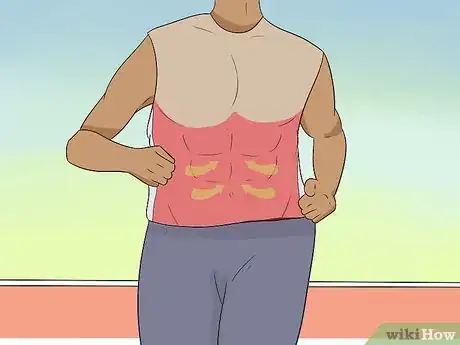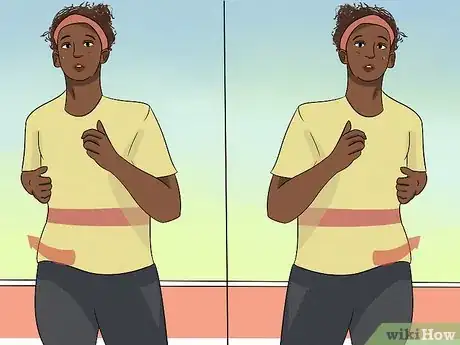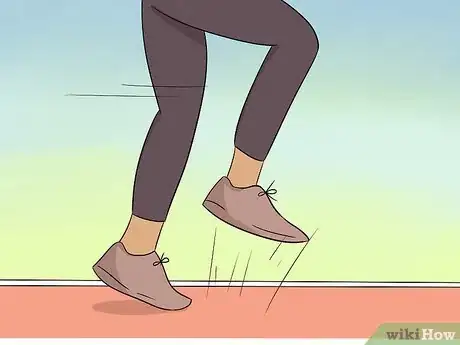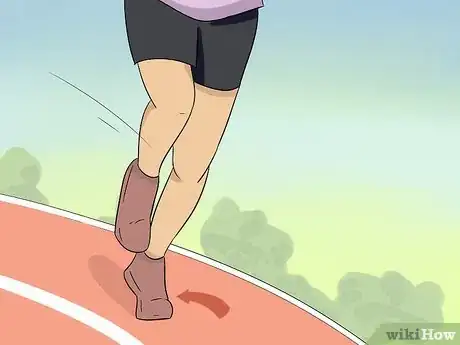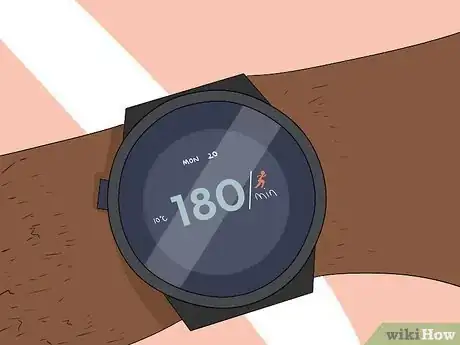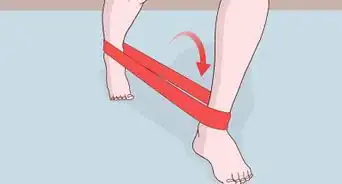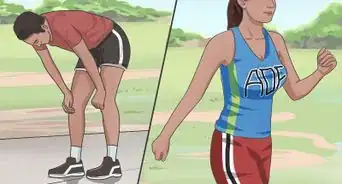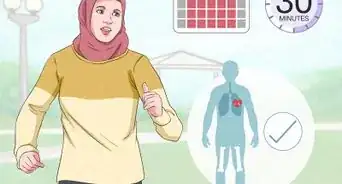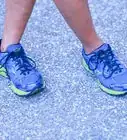This article was co-authored by Kai Ng. Kai Ng is a USATF and RRCA Certified Running Coach at Run Coach Kai. Kai has competed in over 55 races and over 15 marathons, and has trained with 16x USA and World record holder Patti Catalano Dillonso. He specializes in coaching runners of all levels and showing people that everyone can be a runner. Kai is committed to helping his clients reach their goals by showing them how to run with proper form and holding them accountable to train consistently.
This article has been viewed 18,782 times.
Proper running form is an important aspect to all runners from casual jogger to Olympic athletes and marathon runners. Proper running is key to avoiding onset stress-related injuries and improving overall endurance and speed ability. This wiki will go over parts of the body, head to toe, on how they should be moving.
Steps
-
1Keep your eyes looking forward. Always have your eyes focus on what is in front of you. Looking 10-15 meters ahead of you is a good distance for you to identify any obstacles or hazards.
- Looking down may distract you and negatively affect your form.
- While maintaining a forward focus, also take time to make glances at your other surroundings, especially when on a road or sidewalk.
-
2Keep your head level. Make sure to keep your head level with your vision ahead of you.
- Avoid looking down or up, as you will restrict your air ways and put added stress on your neck, which can lead to early fatigue and excess strain. An occasional twist or turn of your head to stretch out your neck is okay, but return to the forward level position afterwards.
Advertisement -
3Relax your shoulders. Maintaining a relaxed position is crucial to avoiding cramps and additional muscle strain. Drop your shoulders to a relaxed position and allow them to sway with the gentle twisting of your body as you run.[1]
- For faster pace running you may want to drop your shoulders back an inch to orient your body more forward.
-
4Keep your chest forward and lean slightly. From a resting position push your chest out about 1 to 1 1/2 inches. Keeping your chest forward and body leaned forward will help to keep your body moving forward and using gravity to push you in the forward direction. From your ankles you should be leaning forward about 10 degrees.
-
5Move your arms with pace. Swing your arms in opposite movements of your forwards foot. This will help to generate momentum and keep you moving forward with ease. Your hands should not break mid-chest level when maintaining pace, however when sprinting your hands may reach or exceed such a level, but should not go past your collar bones. Your hands should also never cross your center; focus on forward and backward movement.
-
6Maintain your elbows at right angle. Your elbows should never be less than 90 degree angles, but may exceed 90 degrees over long distances or heavy inclines. Ensure elbows are close to your sides and not winging out, maintaining a forward motion of your entire arm.
-
7Flex your core/abdominal muscles. Keeping a strong core while running will help to hold your form, if you have a weak core your form will deteriorate, and you may begin to shuffle and slouch. Keep a firm hold on your core, but do not flex to maximum extent, just enough to hold your position.
-
8Keep your hand relaxed. Hold your hand in a slight fist, but relaxed.
- Avoid straightening your hand or holding a very tight fist; have a relaxed hold.
-
9Rotate your hips. Moving your hips back and forth as you stride, but do not over rotate to the point that it restricts movement. Your hips will also move laterally as you extend your legs, let them naturally “bounce” do not force them down or hold them from moving freely.
-
10Maintain consistent knee height. The height at which your knees rise varies on your pace. For sprinting your knees should rise higher, but should not exceed your waistline.
- For a slower pace, knee keep your knees lower, but focus more on the push force rather than knee height to push forward.
-
11Push off your feet. Think of your legs as pistons that push off the ground. Do not focus on the strike down, but rather the push off the ground. Bring your foot down gently, but push off the ground with force, once you have planted.
-
12Land in the center or in front of your foot. When you bring your foot down, try to land first with the front or center of your foot. This allows your foot and leg to act as a dampener, distributing the impact force and taking the stress and strain off your joints and muscles.
- Do not land on your heel, doing so sends all the impact of the strike to your ankle and knee.[2] When aiming for faster paces, you may shift towards your toes more as you lean farther forward.
-
13Strike with your feet underneath your body. When striding, your foot should land underneath your body. Too far ahead and you’ll over stride, too short, and you’ll be wasting momentum, both require more energy than a centered strike. This will keep your stride distance at a proper length and your body moving with optimal efficiency.
-
14Maintain high cadence. You should aim for approximately 180 strikes per minute, more for faster movement, less for a slower pace. If your cadence is too low, you are likely over striding.
- Beepers or music with matching beat pace can help with your cadence.
Warnings
- if you hurt in any way take it easy and don't run so hard.⧼thumbs_response⧽
- Make sure you stretch before running or else you could cause injury.⧼thumbs_response⧽

